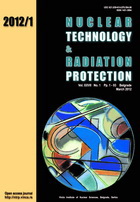
ACCOUNTING FOR DETECTOR CRYSTAL EDGE ROUNDING IN GAMMA-EFFICIENCY CALCULATIONS Theoretical Elaboration and Application in ANGLE Software
Pages: 1-12
Authors: Nikola Mihaljević, Aleksandar Dlabač, Slobodan Jovanović
Abstract
In absolute and semi-empirical calculations of full gamma-energy peak efficiencies (ep), geometrical/compositional data characterizing the detector should be known in much detail. Among these, detector crystal edge rounding (bulletization), if neglected, may lead to large systematic errors, especially for low gamma-energies and close counting geometries. The errors show quadratic dependence on the extent of bulletization (bulletization radius). Mathematical/analytical solution to the problem – not reported so far – is elaborated in the present work. Relevant mathematical formulae are derived for a number of counting arrangements most frequently encountered in gamma-spectrometry practice (point, disc, cylinder, and Marinelli sources). These are subsequently programmed for numerical calculations and are now part of commercially available ANGLE software. Extensive calculation testing is performed for HPGe (both p- and n-type) and LEPD detectors (several sizes each), with various sources (point, disc, cylinder, Marinelli) and counting geometries (0-20 cm source-to-detector distance). Energy range considered was 10-3000 keV. To elucidate the significance of the issue, an error propagation study was conducted: results with bulletization taken into account are compared to those when bulletization was neglected. Corresponding errors are tabulated in an extensive Excel file. The file comprises about 152 000 error calculation results which are available for download; a few characteristic ones are selected for presenting in the paper. ANGLE proved handy (in programming) and fast (in calculations) when accomplishing this task. The data convincingly illustrate the impact of detector bulletization on gamma-efficiency and thus the need to account for. Even only slight bulletization (1-2 mm bulletization radius) is not negligible in many realistic counting situations. Reader/analyst can (1) compare his/her counting situation with these data so as to get the first impression of the problem and (2) use the mathematical model presented and/or ANGLE software to address the issue.
Key words: detector crystal bulletization, semiconductor detectors, efficiency calculations, error propagation, ANGLE software, gamma-spectrometry
FULL PAPER IN PDF FORMAT (8,26 KB)
